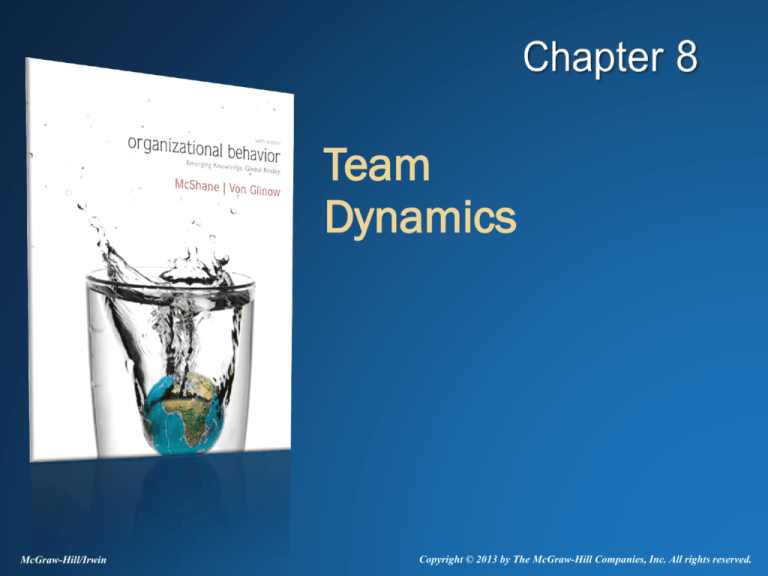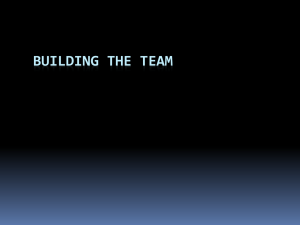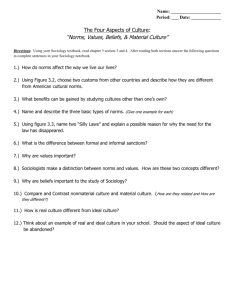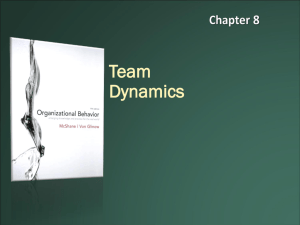
Team
Dynamics
McGraw-Hill/Irwin
Copyright © 2013 by The McGraw-Hill Companies, Inc. All rights reserved.
Teamwork at Reckitt Benckiser
From self-led production teams in the UK to volunteering
and extreme hiking team-building activities in Brazil (as
shown in this photo), household products manufacturer
Reckitt Benckiser thrives on a team spirit.
8-2
What are Teams?
Groups
of two or more people
Exist to fulfill a purpose
Interdependent -- interact and influence each other
Mutually accountable for achieving common goals
Perceive themselves as a social entity
8-3
Many Types of Teams
•
Departmental teams
•
Task force (project)
teams
•
Production/service/
leadership teams
•
Skunkworks
•
Self-directed teams
•
Virtual teams
•
Advisory teams
•
Communities of
practice
8-4
Informal Groups
Groups that exist primarily for the benefit of
their members
Reasons why informal groups exist:
1. Innate drive to bond
2. Social identity -- we define ourselves by group
memberships
3. Goal accomplishment
4. Emotional support
8-5
Advantages/Disadvantages of
Teams
Advantages
1. Make better decisions, products/services
2. Better information sharing
3. Increase employee motivation/engagement
- Fulfills drive to bond
- Accountable to team members, who monitor performance
- Team members are benchmarks of comparison
Disadvantages
1. Individuals better/faster on some tasks
2. Process losses
3. Social loafing
8-6
How to Minimize Social Loafing
Make individual performance more visible
• Form smaller teams
• Specialize tasks
• Measure individual performance
Increase employee motivation
• Increase job enrichment
• Select motivated employees
8-7
Team Effectiveness Model
Team Design
Organizational and
Team Environment
• Rewards
•Task characteristics
•Team size
•Team composition
Team Processes
• Org leadership
• Physical space
• Accomplish tasks
• Satisfy member
needs
• Communication
• Org structure
Team
Effectiveness
• Maintain team
survival
• Team development
• Team norms
• Team cohesiveness
• Team trust
8-8
PSA Peugeot Citroën’s Team Space
PSA Peugeot Citroën, Europe’s
second largest automaker, set
up an “obeya room” (shown
here) to speed up team decision
making. The room, which is
plastered with charts and notes
on key issues, creates a unique
team environment that
encourages face-to-face
interaction to quickly resolve
those issues.
8-9
Organization/Team Environment
Reward systems
Communication systems
Organizational structure
Organizational leadership
Physical space
8-10
Team’s Task Characteristics
Teams are better at tasks that:
• are sufficiently complex (require teamwork)
• can be divided into more specialized roles
requiring frequent coordination
• are well-structured (easier to coordinate)
Teams preferred with higher task
interdependence
• Extent that employees need to share materials,
information, or expertise to perform their jobs.
8-11
Levels of Task Interdependence
High
A
Reciprocal
B
Sequential
A
C
B
C
Resource
Pooled
Low
A
B
C
8-12
Team Size
Smaller teams are better because:
• need less time to coordinate roles and resolve
differences
• require less time to develop
• more member involvement, thus higher
commitment
But team must be large enough to
accomplish task
8-13
Team Composition
Effective team members
must be willing and able to
work on the team
Effective team members
possess specific
competencies
(5 C’s in diagram)
Conflict
Resolving
•Diagnose conflict
sources
•Use best conflicthandling strategy
Team Member
Competencies
Comforting
•Show empathy
•Provide psych
comfort
•Build confidence
Coordinating
•Align work
with others
•Keep team
on track
Communicating
•Share information
freely, efficiently,
respectfully
•Listen actively
8-14
Team Composition: Diversity
Team members have diverse knowledge, skills,
perspectives, values, etc.
Advantages
• view problems/alternatives from different perspectives
• broader knowledge base
• better representation of team’s constituents
Disadvantages
• take longer to become a high-performing team
• more susceptible to “faultlines”
• increased risk of dysfunctional conflict
8-15
Stages of Team Development
Performing
Norming
Storming
Forming
Existing teams
might regress
back to an
earlier stage of
development
Adjourning
8-16
Team Development as
Membership and Competence
Two central processes in team development
1. Team membership formation
• Transition from “them” to “us”
• Team becomes part of person’s social identity
2.
Team competence development
• Forming routines with others
• Forming shared mental models
8-17
Team Roles
A set of behaviors that people are expected
to perform
Some formally assigned; others informally
Informal role assignment occurs during team
development and is related to personal
characteristics
8-18
Team Building
Formal
activities intended to
improve the team’s
development and functioning
Types
of team building
• Clarify team’s performance goals
• Improve team’s problem-solving
skills
• Improve role definitions
• Improve relations
8-19
Team Norms
Informal rules and shared expectations team
establishes to regulate member behaviors
Norms develop through:
• Initial team experiences
• Critical events in team’s history
• Experience/values members bring to the team
8-20
Preventing/Changing Dysfunctional
Team Norms
State desired norms when forming teams
Select members with preferred values
Discuss counter-productive norms
Introduce team-based rewards that counter
dysfunctional norms
Disband teams with dysfunctional norms
8-21
Team Cohesion
•
The degree of attraction people feel toward
the team and their motivation to remain
members
•
Both cognitive and emotional process
•
Related to the team member’s social identity
8-22
Influences on Team Cohesion
Member
similarity
• Similarity-attraction effect
• Some forms of diversity have less effect
Team
size
• Smaller teams tend to be more cohesive
Member
interaction
• Regular interaction increases cohesion
• Calls for tasks with high interdependence
8-23
Influences on Team Cohesion (con’t)
Somewhat
difficult entry
Team
success
External
challenges
• Team eliteness increases cohesion
• But lower cohesion with severe initiation
• Successful teams fulfill member needs
• Success increases social identity with team
• Challenges increase cohesion when not
overwhelming
8-24
Team Cohesion Outcomes
1.
Motivated to remain members
2.
Willing to share information
3.
Better social support
4.
Resolve conflict effectively
5.
Better interpersonal relationships
6.
Better performance
But only if norms are aligned with org goals
Also, effect of performance on cohesion might be
stronger than vice versa
8-25
Team Cohesion and Performance
Team Norms
Support
Company
Goals
Team Norms
Oppose
Company
Goals
Moderately
high task
performance
High task
performance
Moderately
low task
performance
Low task
performance
Low Team
Cohesion
High Team
Cohesion
8-26
Trust in Teams
Positive expectations one person has of
another person in situations involving risk
Three levels of trust
Swift trust
• New team members tend to have moderate or
higher trust in co-workers
• Trust is fragile in new relationships – based on
assumptions, not experience – so easily broken
8-27
Three Levels of Trust
High
Identification-based Trust
Knowledge-based Trust
Calculus-based Trust
Low
8-28
Self-Directed Teams at Whole
Foods Markets
Whole Foods Markets organizes employees around selfdirected teams, responsible for a particular store area.
These teams have considerable autonomy to operate
their store section.
8-29
Self-Directed Teams Defined
Cross-functional groups organized around work
processes, that complete an entire piece of work
requiring several interdependent tasks, and that have
substantial autonomy over the execution of those tasks.
8-30
Self-Directed Team Success Factors
Responsible for entire work process
High interdependence within the team
Low interdependence with other teams
Autonomy to organize and coordinate work
Work site and technology support team
communication/coordination
8-31
Virtual Teams
Teams whose members operate across space,
time, and organizational boundaries and are
linked through information technologies to
achieve organizational tasks
• Increasingly possible because of:
- Information technologies
- Knowledge-based work
• Increasingly necessary because of:
- Organizational learning
- Globalization
8-32
Virtual Team Success Factors
Member characteristics
• Communication technology skills
• Self-leadership skills
• Emotional intelligence
Flexible use of communication technologies
Fairly high task structure
Opportunities to meet face-to-face
8-33
Team Decision Making Constraints
Time constraints
• Time to organize/coordinate
• Production blocking
Evaluation apprehension
• Belief that others are silently evaluating you
Peer pressure to conform
• Suppressing opinions that oppose team norms
Groupthink
• Tendency in highly cohesive teams to value consensus
at the price of decision quality
• Concept losing favor – study specific elements
8-34
General Guidelines for
Team Decisions
1.
Team norms should encourage critical
thinking
2.
Sufficient team diversity
3.
Ensure neither leader nor any member
dominates
4.
Maintain optimal team size
5.
Introduce effective team structures
8-35
Constructive Conflict
People focus their discussion on the issue
while maintaining respectfulness for others
having different points of view.
Problem: constructive conflict easily slides
into personal attacks
8-36
Brainstorming
Team structure in which participants try to think
up as many ideas as possible.
Four specific rules to follow
•
•
•
•
Speak freely
Don’t criticize
Provide as many ideas as possible
Build on others’ ideas
Dismissed by research, but embraced by some
of the world’s most creative firms
• Reason: Brainstorming works under specific conditions
but lab studies haven’t replicated those conditions
8-37
Evaluating Brainstorming
Strengths
• Produces more creative ideas (under some conditions)
• Less evaluation apprehension when team supports a
learning orientation
• Strengthens decision acceptance and team
cohesiveness
• Sharing positive emotions encourages creativity
Weaknesses
• Production blocking still exists
• Evaluation apprehension exists in many groups
8-38
Electronic Brainstorming
Relies on networked computers to submit
and share creative ideas
Strengths -- more creative ideas, minimal
production blocking, evaluation
apprehension, or conformity problems
Limitations -- too structured and technologybound
8-39
Nominal Group Technique
Describe
problem
Individual
Activity
Team
Activity
Individual
Activity
Write down
possible
solutions
Possible
solutions
described
to others
Vote on
solutions
presented
8-40
Team
Dynamics








